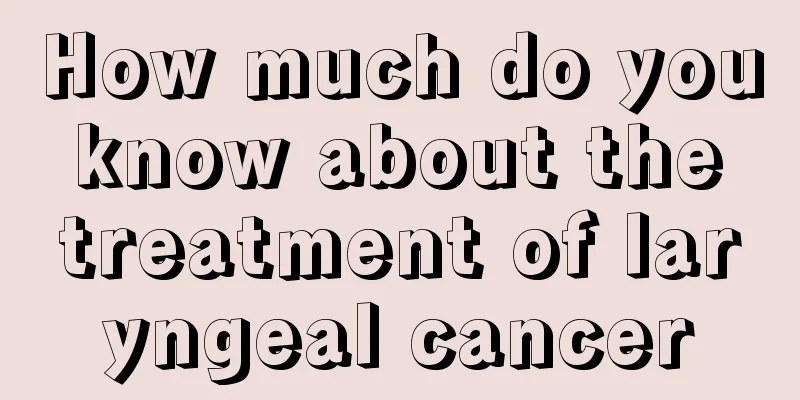What's the matter with a small pimple on the upper eyelid

|
Some people have small bumps on their eyelids, which are a bit painful or itchy, but look uncomfortable. After going to the hospital, some doctors said it was a stye, which is mainly caused by staphylococcal infection. The main symptoms are local redness and swelling, slight pain, and yellow pus spots. In this case, you should pay more attention to protecting your eyelids and seek medical treatment in time to avoid serious consequences. So, what is a stye? Stye, also known as sty and hordeolum, is an acute suppurative inflammation of the sebaceous glands or meibomian glands near the eyelash follicles. There are two types of styes: internal sty and external sty: 1. External stye It is an acute suppurative inflammation of the Zeis gland. Initially, the eyelid margin shows localized congestion and swelling, and a nodule forms after 2 to 3 days. There is obvious swelling, pain and tenderness. Later, the nodule gradually softens and a yellow pustule forms at the root of the eyelashes, which breaks through and discharges pus quickly. Severe cases may have systemic symptoms such as chills and fever. 2. Internal stye It is an acute purulent inflammation of the meibomian glands. Its clinical symptoms are not as severe as those of external hordeolum, because the inflamed meibomian glands are surrounded by firm tarsal plate tissue. Yellow pus masses are often faintly visible on the surface of the congested palpebral conjunctiva, which may rupture and discharge pus into the conjunctival sac on their own. The opening of the meibomian glands may be slightly raised and congested, and pus may also be discharged along the palpebral gland duct. A few cases may rupture and discharge pus from the skin. If the tarsal plate fails to rupture and the pathogen is highly toxic, the inflammation will expand, invade the entire tarsal plate tissue, and form an eyelid abscess. Causes of stye: There are two kinds of glands on the eyelids. The sebaceous glands at the root of the eyelashes open into the hair follicles. The meibomian glands are buried in the tarsal plates near the conjunctival surface and open into the eyelid margins. Stye is an acute suppurative inflammation of these two glands. The bacteria that cause styes are mostly Staphylococcus aureus. Clinical manifestations of stye: 1. Localized redness, swelling, heat and pain on the eyelid skin, and edema of the adjacent conjunctiva. 2. When pus accumulates locally, yellow pus heads appear. External styes occur in the sebaceous glands at the root of the eyelashes and appear on the skin surface; internal styes occur in the meibomian glands and appear on the conjunctival surface. After rupture and drainage of pus, the pain is relieved and the redness and swelling subside. 3. Severe cases are accompanied by enlarged and tender preauricular and submandibular lymph nodes, general chills, fever, etc. Treatment of stye: 1. Early hot compress or magnetic therapy Promote infiltration absorption or rapid suppuration of nodules. 2. Surgical incision When the inflammation is under control and pus accumulates to form a fluctuating feeling, it can be drained by incision, and the necrotic or granulation tissue can be properly cleaned. Depending on the situation, placement of a drainage strip can be considered. After the inflammation subsides, if there is still residual granulation tissue or nodules left, surgical removal can be performed again. However, it should be noted that the skin incision of the external hordeolum should be parallel to the eyelid margin, and the conjunctival incision of the internal hordeolum should be perpendicular to the eyelid margin. Avoid inappropriate squeezing to prevent the inflammation from spreading into the orbit and cranium, causing orbital cellulitis, cavernous sinus phlebitis, meningitis and abscess, which may be life-threatening. 3. For stubborn and recurrent cases Autoimmune therapy is available. Patients with systemic fever and swollen preauricular and submandibular lymph nodes can be treated with antibiotics. |
<<: What's going on with this small bump on my upper jaw?
>>: What is the disease of red bumps on the body after taking a bath
Recommend
How can we effectively prevent the occurrence of rectal cancer?
Nowadays, more and more people are suffering from...
What are the early symptoms of lymphoma
What are the early symptoms of lymphoma? 1. Lymph...
Warm-up exercises before morning jogging
Morning jogging helps us improve our body's r...
What is the difference between the free and self-paid meningococcal vaccines
Self-paid vaccines mean that you have to pay for ...
What is the chance of recurrence of ovarian teratoma after surgery?
Ovarian teratomas are common in women of childbea...
How to exercise after ovarian cancer surgery
Many people believe that cancer patients are weak...
Can you urinate out a prostate cyst?
Prostatic cysts usually cannot be discharged thro...
Can malignant cervical cancer be cured?
Can malignant cervical cancer be cured? Cervical ...
What are the early symptoms of lung cancer? There are 7 common manifestations of early lung cancer
The earlier most diseases are treated, the easier...
What are the symptoms of spina bifida occulta
The development of the human spine is a process o...
How to avoid lung cancer?
Many friends are worried about lung cancer, so ho...
How to prevent lung cancer in the early stages 5 tips to prevent lung cancer
As the air quality gradually declines, the number...
How much does chemotherapy for colon cancer cost?
How much does chemotherapy for colon cancer cost?...
Immunotherapy for liver cancer
The purpose of immunotherapy for liver cancer is ...
Is hot water compress effective for allergic rhinitis?
Allergic rhinitis is a common symptom of rhinitis...









